Electricity class 10 notes || NCERT solution of Electricity class 10|| Electricity Class 10 Notes Science Chapter 12||VECTOR STUDIES
ELECTRICITY
QUICK REVISION EXPRESS
CHARGE:
-It is the property of a matter by which it attract or repel each other matter.
Charge are of two types-
- Positive charge-It is a type of charge which is produced due to the deficiency of electron on a body or a particle.
- Negative charge- It is a type of charge which is produced due to the excess of electrons on a body or a particle.
Properties of charge:
- Like charges repel and unlike charges attract each other.
- The total charge of an isolated physical system is always conserved.
- Charge can assume only certain discrete values or integer not in fraction.
- Charge can neither be created nor be destroyed, rather it can only be transferred from one body to another.
- SI unit- coulamb(c).
- One coulamb- A body said to have one coulomb of charge if it contain 6.25×10 raised to the power 18 electrons.
- 1 milicoulamb= 10 raised to the power minus 3 coulamb.
- 1 microcoulamb=10 raised to the power minus 6 coulomb.
- Charge on one electron- 1.6 × 10-19 C
- [Q=n×e]
- n=number of electrons. and e=charge on one electron.
ElECTRIC CURRENT:
- The rate of flow of charge through a conductor is called the electric current.
- It is measured as the amount of electric charge passing through any cross section of a conductor in unit time.
- The unit of electric current is Ampere (A).
- Electric current is measured by Ammeter.
- Direction of flow of electric current is positive direction.
-Where Q is amount of charge and T is time.
Define one Ampere-
-1 ampere is the current in a conductor when 1 coulomb of charge flow through the conductor in one second.
ELECTRIC POTENTIAL
- The amount of work done needed to move a unit electric charge from infinity to a specific point in an electric field is known as electric potential.
- Formula-V=W/Q
- Denote with- V
- The amount of work done needed to bringing a unit positive charge from a reference point to a specific point.
- Denoted with - ∆V or V
- ∆V= W/Q
- It is measured by a device known as VOLTMETER.
- SI unit - Volts
- One volt is the potential difference between two point in a current carrying conductor when one joule of work done is used to move a charge of 1 coulomb between two points.
- 1VOLT=1JOULE/1COULAMB.
ELECTRIC CIRCUIT
- It is a closed and contineous path of electric current.
- It is made by circuit diagram.
- It states that the electric current flowing in a conductor is directly proportional to the potential difference across the end of a conductor at constant temperature.
- According to it - V ∝ I
- V = IR
RESISTANCE
- It is a property of a conductor that opposes the flow of electric current.
- Denoted with- R
- SI unit- ohm
Note - Rheostat=It is a device which is used to to change the resistance in an electric circuit
Resistor= A conductor having some appreciable resistance
Factor on which resistance depend-
- Length of the conductor [resirtance is directly proportional]
- Area of cross section[ (R) ∝ 1/Area of cross section]
- Material of the conductor [resistance is directly proportional to resistivity]
Thus, resistance (R) ∝ 1/Area of cross section of conductor (A)
or, R ∝
From equations (i) and (ii)
R ∝
R = ρ
Where, ρ (rho) is the proportionality constant. It is called the electrical resistivity of the material of conductor.
From equation (iii) RA = ρl ⇒ ρ =
I
RESISTIVITY
- It is the material dependent property that resist the flow of electric current.
- Denoted with-ρ (rho)
- SI unit- ohm meter.
- Resistivity of alloy is generally higher than metals.
- Due to this property they are used in heating devices.
- Metals and alloys have very low resistivity in the range of 10-8 O m to 10-6 Q m. They are good conductors of electricity.
- Insulators have resistivity of the order of 1012 to 1017 Q m. They are bad conductors of electricity.
Note- Alloy have high resistivity and do not oxidized easily for this season they are used in some electrical instruments like iron heaters and poster etc for the heating effect.
COMBINATION OF RESISTANCE
1-SERIES CONNECTION
- Registers are connected in series that is join and to end.
- The current through the circuit is same.
- The potential difference across each register is different.
Let, three resistors R1, R2, and R3 get connected in series.
Potential difference across A and B = V
Potential difference across R1, R2 and R3 = V1, V2 and V3
Current flowing through the combination = I
We, know that
V= V1 + V2 + V3 …. (i)According to Ohm’s Law :
V1 = IR1, V2 = IR2 and V3 = IR3 ….. (ii)
Let, total resistance = Rs
Then, V = IRs …(iii)
From equations (i) and (ii) and (iii)
IRs = IR1 + IR2 + IR3
Rs = R1 + R2 + R3
When the resistors are connected in series, the current flowing through each resistor is the same and is equal to the total current.
PARALLEL CONNECTION
- Resistance are connected to the same end.
- The potential difference through each register is same
- The current through each register is divide.
Consider potential difference across the resistors be V & the current flowing through resistors R1, R2 & R3 be I1, I2 & I3 respectively. Let the total current flowing through the circuit be I & equivalent resistance be Rp.
By Ohm’s law,
I = V/Rp ; I1 = V/R1 ; I2 = V/R2 ; I3 = V/R3
Now, I = I1 + I2 + I3
or , V/Rp = V/R1 + V/R2 + V/R3
or , 1/Rp = 1/R1 + 1/R2 + 1/R3
Advantages of parallel combination over series combination:-
- In series combination, current remains same throughout the circuit while in parallel combination, current is different through each device and different components require different currents to operate properly.
- If one device fails in series circuit then none of the devices works while it will not happen in parallel circuit.
- The total resistance in a parallel circuit is decreased while the total resistance in series circuit is increased.
- In parallel connection each appliances get his own requirement current.
HEATING EFFECT OF ELECTRIC CURRENT
-When electric current is passed through the conductor due to repetitive collision between moving charge and atoms heat is produced.
JOULE's LAW OF HEATING
According to Joule’s law of heating, heat produced in a resistor is directly proportional to
- square of current (H ∝ I2)
- resistance (H ∝ R)
- time for which current flows (H ∝ t)
H = I2Rt
Practical Applications of Heating Effect of Electric Current:-
Appliances based on heating effect of electric current are electric bulb, electric iron, electric toaster, electric oven, electric kettle, electric heater, fuse etc.
- Tungsten is used as the filament of the electric bulb.[melting point 3380 degree celsious]
- The bulbs are filled with chemically inactive gases like nitrogen and argon to prolong the life of the filament.
- P =
Wt
- P = VI
- P =
E/TtEt
We know that electric work done, W = V × I × t or P =
P = VI
Electric power in watts = 1Volts × 1ampere
So P = IR × I
P = I2R
P = (
Unit of electric energy is kilowatt-hour (kWh).
1 kWh = 1000 watt × 1 hour = 1 unit = 1000 W × 3600 s
1 kWh = 3.6 x 106 watt second = 3.6 × 106 J
NCERT Solutions for Class 10 Science Chapter 12 Electricity
Page Number: 200
Question 1
What does an electric circuit mean ?
Answer:
A continuous and closed path of electric current is called an electric circuit.
Question 2
Define the unit of current.
Answer:Unit of current is ampere. If one coulomb of charge flows through any section of a conductor in one second then the current through it is said to be one ampere.
Page Number: 202
Question 1
Name a device that helps to maintain a potential difference across a conductor.
Answer:
A battery.
Question 2
What is meant by saying that the potential difference between two points is IV?
Answer:
The potential difference between two points is said to be 1 volt if 1 joule of work is done in moving 1 coulomb of electric charge from one point to the other.
Question 3
How much energy is given to each coulomb of charge passing through a 6 V battery ?
Answer:
Energy given by battery = charge x potential difference
or W = QV = 1C X 6V = 6J
Page Number: 209
Question 1
On what factors does the resistance of a conductor depend ?
OR
List the factors on which the resistance of a conductor in the shape of a wire depends. [CBSE2018]
Answer:
The resistance of a conductor depends (i) on its length (ii) on its area of cross-section and (iii) on the nature of its material.
Question 2
Will current flow more easily through a thick wire or a thin wire of the same material, when connected to the same source ? Why ?
Answer:
The current will flow more easily through a thick wire than a thin wire of the same material. Larger the area of cross-section of a conductor, more is the ease with which the electrons can move through the conductor. Therefore, smaller is the resistance of the conductor
Question 3
Let the resistance of an electrical component remains constant while the potential difference across the two ends of the component decreases to half of its former value. What change will occur in the current through it ?
Answer:
When potential difference is halved, the current through the component also decreases to half of its initial value. This is according to ohm’s law i.e., V ∝ I.
Question 4
Why are coils of electric toasters and electric irons are made of an-alloy rather than a pure metal ?
OR
Why are alloys commonly used in electric heating devices? Given reason. [CBSE 2018]
Answer:
The coils of electric toasters, electric irons and other heating devices are made of an alloy rather than a pure metal because (i) the resistivity of an alloy is much higher than that of a pure metal, and (ii) an alloy does not undergo oxidation (or burn) easily even at high temperature, when it is red hot
Page Number: 213
Question 1
Judge the equivalent resistance when the following are connected in parallel :
(i) 1 Ω and 106 Ω,
(if) 1 Ω and 103 Ω and 106 Ω.
Answer:
When the resistances are connected in parallel, the equivalent resistance is smaller than the smallest individual resistance.
(i) Equivalent resistance < 1 Ω.
(ii) Equivalent resistance < 1 Ω
Question 2
An electric lamp of 100 Ω, a toaster of resistance 50 Ω, and a water filter of resistance 500 Ω are connected in parallel to a 220 V source. What is the resistance of an electric iron connected to the same source that takes as much current as all three appliances, and what is the current through it ?
Solution:
Resistance of electric lamp, R1 = 100 Ω
Resistance of toaster, R2 = 50 Ω
Resistance of water filter, R3 = 500 Ω
Equivalent resistance Rp of the three appliances connected in parallel, is
Resistance of electric iron = Equivalent resistance of the three appliances connected in parallel = 31.25 Ω
Applied voltage, V = 220 V
Current, I =
Question 3
What are the advantages of connecting electrical devices in parallel with the battery instead of connecting them in series ?
Answer:
Advantages of connecting electrical devices in parallel with the battery are :
- In parallel circuits, if an electrical appliance stops working due to some defect, then all other appliances keep working normally.
- In parallel circuits, each electrical appliance has its own switch due to which it can be turned on turned off independently, without affecting other appliances.
- In parallel circuits, each electrical appliance gets the same voltage (220 V) as that of the power supply line.
(ii) We can obtain a total resistance of 1Ω by connecting resistors of 2 Ω, 3 Ω and 6 Ω in parallel.![]()
Question 5
What is (i) the highest, (ii) the lowest total resistance that can be secured by combinations of four coils of resistance 4 Ω, 8 Ω, 12 Ω, 24 Ω?
Solution:
(i) Highest resistance can be obtained by connecting the four coils in series.
Then, R = 4Ω + 8Ω + 12Ω + 24Ω = 48Ω
(ii) Lowest resistance can be obtained by connecting the four coils in parallel.![]()
Page Number: 218
Question 1
Why does the cord of an electric heater not glow while the heating element does ?
Solution:
Heat generated in a circuit is given by I2R t. The heating element of an electric heater made of nichrome glows because it becomes red-hot due to the large amount of heat produced on passing current because of its high resistance, but the cord of the electric heater made of copper does not glow because negligible heat is produced in it by passing current because of its extremely low resistance.
Question 2
Compute the heat generated while transferring 96000 coulomb of charge in one hour through a potential difference of 50 V.
Solution:
Here, Q = 96,000 C, t =1 hour = 1 x 60 x 60 sec = 3,600 s, V = 50 V
Heat generated, H = VQ = 50Vx 96,000 C = 48,00,000 J = 4.8 x 106 J
Question 3
An electric iron of resistance 20Ω takes a current of 5 A. Calculate the heat developed in 30 s.
Solution:
Here, R = 20 Ω, i = 5 A, t = 3s
Heat developed, H = I2 R t = 25 x 20 x 30 = 15,000 J = 1.5 x 104 J
Page Number: 220
Question 1
What determines the rate at which energy is delivered by a current ?
Answer:
Resistance of the circuit determines the rate at which energy is delivered by a current.
Question 2
An electric motor takes 5 A from a 220 V line. Determine the power of the motor and the energy consumed in 2 h.
Answer:
Here, I = 5 A, V = 220 V, t = 2h = 7,200 s
Power, P = V I = 220 x 5 = 1100 W
Energy consumed = P x t = 100 W x 7200 s = 7,20,000 J = 7.2 x 105 J
BACK EXERCISE
Question 1
A piece of wire of resistance R is cut into five equal parts. These parts are then connected in parallel. If the equivalent resistance of this combination is R’, then the ratio R/R’ is :
(a)
(b)
(c) 5
(d) 25
Answer:
(d) 25
Question 2
Which of the following terms does not represent electrical power in a circuit?
(a) I2R
(b) IR2
(c) VI
(d)
Answer:
(B) IR2
Question 3
An electric bulb is rated 220 V and 100 W. When it is operated on 110 V, the power consumed will be :
(a) 100 W
(b) 75 W
(c) 50 W
(d) 25 W
Answer:
(d) 25 W
Question 4
Two conducting wires of the same material and of equal lengths and equal diameters are first connected in series and then parallel in a circuit across the same potential difference. The ratio of heat produced in series and parallel combinations would be :
(a) 1 : 2
(b) 2 : 1
(c) 1 : 4
(d) 4 : 1
Answer:
(c) 1 : 4
Question5-How is a voltmeter connected in the circuit to measure the potential difference between two points ?
Answer:
A voltmeter is connected in parallel to measure the potential difference between two points
Question 6:
A copper wire has a diameter 0.5 mm and resistivity of 1.6 X 10-8 Ωm. What will be the length of this wire to make its resistance 10 Ω? How much does the resistance change if the diameter is doubled?
Answer: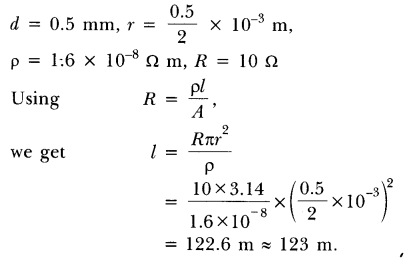
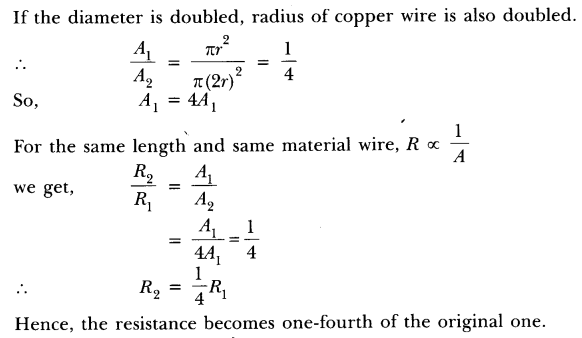
Question 7:
The values of the current I flowing in a given resistor for the corresponding values of potential difference V across the resistor are given below:
Plot a graph between V and I and calculate the resistance of that resistor.
Answer: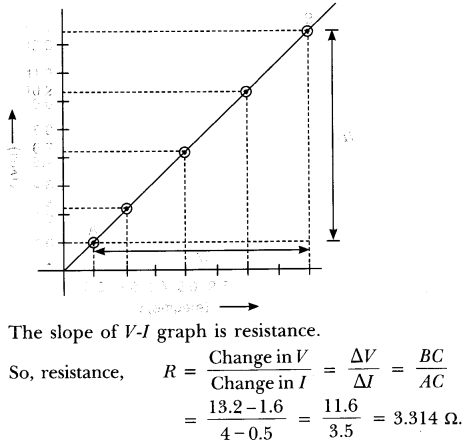
Question 8:
When a 12 V battery is connected across an unknown resistor, there is a current of 2.5 mA in the circuit. Find the value of the resistance of the resistor.
Answer:
Question 9:
A battery of 9 V is connected in series with resistors of 0.2 Ω, 0.3 Ω, 0.4 Ω, 0.5 Ω and 12 Ω, respectively. How much current would flow through the 12 Ω resistor?
Answer:
Since all the resistors are in series, the same current, 0.67 A flows through the 12 Ω resistor.
Question 10:
How many 176 Ω resistors (in parallel) are required to carry 5 A on a 220 V line?
Answer: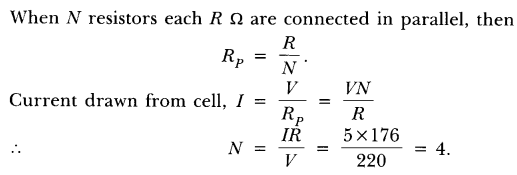
Question 11:
Show how you would connect three resistors, each of resistance 6 Ω , so that the combination has a resistance of (i) 9 Ω , (it) 4 Ω .
Answer:
(i) When two 6 Ω resistances are in parallel and the third is in combination to this, the equivalent resistance will be 9 Ω.
(ii) When two 6 Ω resistances are in series and the third is in parallel to them, then it will be 4 Ω.
Question 12:
Several electric bulbs designed to be used on a 220 V electric supply line, are rated 10 W. How many lamps can be connected in parallel with each other across the two wires of 220 V line if the maximum allowable current is 5 A?
Answer:
Since, N bulbs of power P each connected in parallel will make the total power of NP,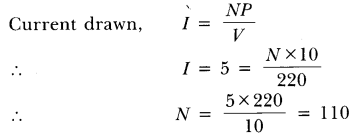
Question 13:
A hot plate of an electric oven connected to 220 V line has two resistance coils A and B, each of 24 Q resistance, which may be used separately, in series, or in parallel. What are the currents in the three cases?
Answer: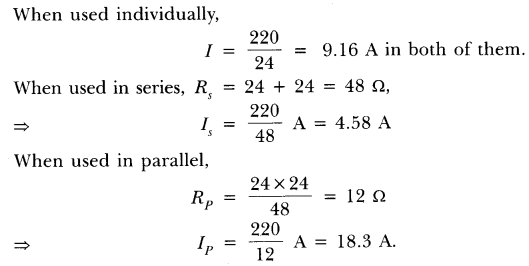
Question 14:
Compare the power used in the 2 Ω resistor in each of the following circuits.
(i) a 6 V battery in series with 1 Ω and 2 Ω resistors, and
(ii) a 4 V battery in parallel with 12 Ω and 2 Ω resistors.
Answer: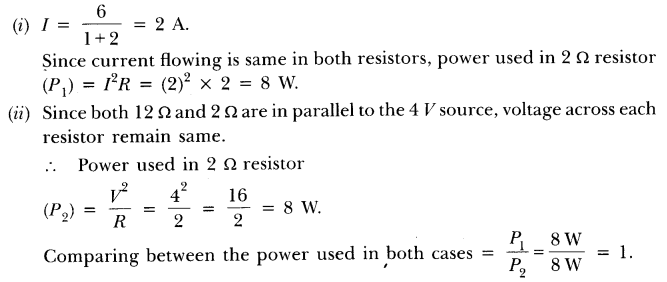
Question 15:
Two lamps, one rated 100 W at 220 V, and the other 60 W at 220 V, are connected in parallel to electric mains supply. What current is drawn from the line if the supply voltage is 220 V?
Answer:
Question 16:
Which uses more energy, a 250 W TV set in 1 hr, or a 1200 W toaster in 10 minutes?
Answer:
Energy consumed by 250 W TV set in 1 h = 250 x 1 = 250 Wh.
Energy consumed by 1200 W toaster in 10 min = 1200 X 1/6 = 200 Wh.
∴ Energy consumed by TV set is more than the energy consumed by toaster in the given timings.
Question 17:
An electric heater of resistance 8 f2 draws 15 A from the service mains 2 hours. Calculate the rate at which heat is developed in the heater.
Answer:
.jpeg)


.png)


.jpeg)



